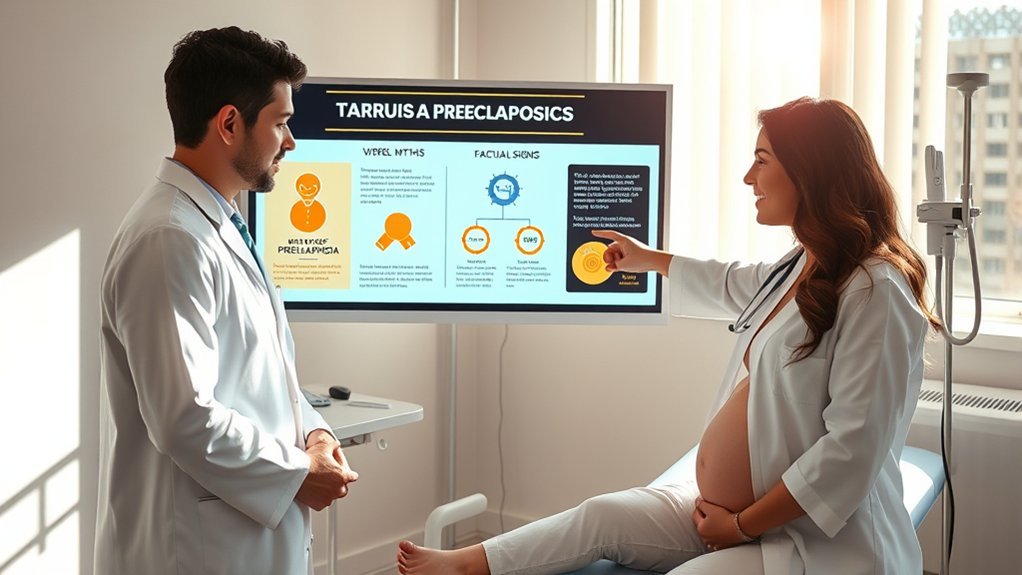Imagine maneuvering through the complexities of pregnancy, only to encounter the shadow of preeclampsia lurking in the background. This condition is often shrouded in misconceptions, leading many to overlook critical signs beyond just elevated blood pressure. Understanding the myths versus the facts can be pivotal in safeguarding both maternal and fetal health. So, what should you really watch for, and how can you guarantee timely intervention? The answers might surprise you.
Understanding Preeclampsia: The Basics

Preeclampsia is a serious pregnancy complication characterized by high blood pressure and signs of damage to other organ systems, often the kidneys. It typically occurs after the 20th week of pregnancy and can affect both you and your baby.
Symptoms may include headaches, visual disturbances, and swelling, particularly in the hands and face. Monitoring your blood pressure regularly is essential, as elevated readings can indicate the onset of preeclampsia. If you notice any concerning symptoms, contact your healthcare provider immediately.
Risk factors include a history of hypertension, obesity, and carrying multiple pregnancies. Early detection and management can greatly reduce complications, ensuring better outcomes for both you and your child.
Always discuss any concerns with your healthcare team for tailored guidance.
Common Myths About Preeclampsia

You might believe that high blood pressure is the only indicator of preeclampsia, but it can also present with other symptoms like protein in the urine and swelling.
Additionally, many think this condition only affects first-time mothers, when in reality, it can occur in any pregnancy.
Understanding these myths is essential for recognizing the signs and seeking timely medical attention.
High Blood Pressure Only
While high blood pressure is a significant indicator of preeclampsia, it’s a common misconception that it’s the only sign to watch for.
In reality, preeclampsia can present with a range of symptoms beyond elevated blood pressure. You should also be aware of swelling in the hands and face, sudden weight gain, severe headaches, and changes in vision, such as blurred vision or light sensitivity.
These symptoms, along with high blood pressure, can indicate the condition’s severity. Early detection and intervention are vital, as untreated preeclampsia can lead to serious complications for both you and your baby.
Always consult your healthcare provider if you experience any concerning symptoms during pregnancy to guarantee proper monitoring and care.
Only Affects First-Time Mothers
Many believe that preeclampsia only affects first-time mothers, but this is a common misconception. In fact, preeclampsia can occur in women who’ve had previous pregnancies, and risk factors vary widely. Understanding this can help you recognize the signs, regardless of your pregnancy history.
Consider these points:
- Severity can increase: Even if you’d a healthy pregnancy before, preeclampsia can develop in subsequent ones.
- Risk factors accumulate: Factors like age, obesity, and family history may elevate your risk in later pregnancies.
- Awareness is vital: Knowing the signs early can lead to timely treatment, potentially reducing complications for you and your baby.
Preeclampsia is unpredictable; don’t dismiss it based on past experiences.
Recognizing the True Signs of Preeclampsia

Recognizing the true signs of preeclampsia is vital, as early detection can greatly influence both maternal and fetal health.
Watch for symptoms such as persistent headaches, visual disturbances, sudden swelling in your hands or face, and rapid weight gain. High blood pressure, typically over 140/90 mmHg, is a key indicator.
You may also notice abdominal pain, particularly in the upper right quadrant. It’s important to monitor these signs closely; if you experience any, don’t hesitate to contact your healthcare provider.
Risk Factors Associated With Preeclampsia
Understanding the risk factors associated with preeclampsia is essential for managing your health during pregnancy. Certain factors can increase your likelihood of developing this condition, and being aware of them can help you take proactive steps.
Consider these key risk factors:
- Previous history: If you’ve had preeclampsia in a previous pregnancy, your risk increases.
- Chronic conditions: High blood pressure, diabetes, or kidney disease can heighten your chances of developing preeclampsia.
- Lifestyle factors: Obesity and a sedentary lifestyle are linked to a higher occurrence of this condition.
The Importance of Early Detection
Early detection of preeclampsia is essential, as timely intervention can greatly improve outcomes for both you and your baby.
Recognizing the signs early allows healthcare providers to monitor your condition closely and implement necessary treatments. Studies show that prompt diagnosis can reduce the risk of severe complications, such as organ damage and preterm birth.
Monitoring blood pressure and urine protein levels regularly during prenatal visits is vital in identifying preeclampsia. If you have risk factors, your healthcare provider may recommend more frequent check-ups.
Being vigilant about any symptoms, like headaches or visual disturbances, can also aid in early detection. Remember, proactive management is key in ensuring a healthier pregnancy trajectory for you and your child.
What to Do If You Experience Symptoms
If you notice symptoms such as severe headaches, vision changes, or sudden swelling, it’s important to seek medical attention immediately.
These signs could indicate preeclampsia, which can escalate rapidly and pose risks to both you and your baby.
When you contact your healthcare provider, consider mentioning:
- Headaches that are unresponsive to usual pain relief
- Blurred or double vision, which may signal elevated blood pressure
- Swelling in your hands and face, indicating fluid retention
A prompt evaluation may involve monitoring your blood pressure, urine tests, and possibly blood work.
Don’t hesitate to advocate for yourself; early intervention is vital in managing preeclampsia and ensuring a safer outcome for you and your child.
Frequently Asked Questions
Can Preeclampsia Occur After Childbirth?
Yes, preeclampsia can occur after childbirth, known as postpartum preeclampsia. It usually develops within 48 hours to six weeks after delivery, so it’s essential to monitor your blood pressure and report any concerning symptoms promptly.
How Does Preeclampsia Affect Future Pregnancies?
Women who’ve had preeclampsia have a 20-40% chance of experiencing it in future pregnancies. This condition can lead to complications like hypertension and organ damage, so managing risk factors is essential for healthier outcomes.
Are There Any Long-Term Effects of Preeclampsia?
Yes, preeclampsia can lead to long-term effects, including an increased risk of cardiovascular disease, kidney issues, and future pregnancy complications. Monitoring your health post-pregnancy is essential for managing these potential risks effectively.
Is There a Cure for Preeclampsia?
There’s no cure for preeclampsia; the only definitive treatment is delivering the baby. Managing symptoms and monitoring your health can help, but the condition typically resolves after childbirth. Always consult your healthcare provider for personalized guidance.
Can Lifestyle Changes Prevent Preeclampsia?
You can’t completely prevent preeclampsia with lifestyle changes, but maintaining a healthy diet, regular exercise, and managing stress might reduce risk factors. It’s ironic how small choices can influence such a complex condition.
Conclusion
To sum up, understanding the realities of preeclampsia is essential for protecting both you and your baby. Don’t let myths cloud your judgment; pay attention to the signs and seek medical advice if you notice symptoms. Like a lighthouse guiding ships away from rocky shores, early detection can steer you towards safer waters. By staying informed and vigilant, you can greatly improve outcomes for both you and your child, ensuring a healthier pregnancy journey.
